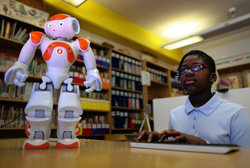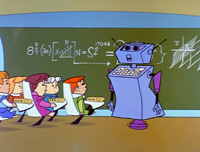redo Jump to...
print Print...
(by Sophia Hollander, The Wall Street Journal) – In a handful of public schools in the U.S. this year, robots will be teaching everything from math to vocabulary to nutrition inside classrooms in California and New York, a move the researchers call a first in American education.
The Los Angeles experiment, scheduled to start later this spring, will use a robotic “dragon” to teach first-graders about healthy lifestyle habits. Students will help show the robot how to prepare for a race; the hope is that by sharing tips with the dragon, they take their own lessons to heart.
The robot in the Los Angeles trial costs about $5,500 when stylish touches such as fur, feet and wings are added. The effort is the first of several robot experiments planned and is backed by a five-year, $10 million grant from the National Science Foundation (see “Background” below). It will be conducted by a coalition of researchers from Yale University, the Massachusetts Institute of Technology, the University of Southern California and Stanford University.
Researchers see the classroom robots not as replacements for teachers but as whimsical assistants programmed to push kids’ buttons. [People opposed to using robots] see the mechanization as the latest example of technology undermining the importance of human connections in the classroom.
The robot educators, most of which are small enough to perch on a table, don’t replace teachers, exactly. Kids generally take turns with them in special sessions in a library or on the side of the classroom. The robots are programmed to mimic human behaviors: swiveling their heads when students speak, crying out when overeager kids get physical, and gesturing as they talk.
“How can you get the kids to do more math? They don’t want to. But they do want to play with the robots,” said Maja Matarić, professor of computer science, neuroscience and pediatrics at USC, who is helping to lead the project in Los Angeles. Robots in the experiments are teaching and reinforcing lessons over several weeks, researchers say, even though it seems they are merely serving as electronic playmates.
The New York robot experiment relies on a basic insight: Children don’t like admitting mistakes but they enjoy pointing out someone else’s. The idea was to “use that to our advantage,” said Sandra Okita, an assistant professor at Teachers College, Columbia University, who is leading the experiment.

‘Projo’ the robot, part of an experiment run by Teachers College, Columbia University, works with Oumou Doumbia at a New York school.
She programmed her robot – a $14,000 android nicknamed “Projo,” with glowing eyes, bulging triceps and a futuristic-looking white and orange spacesuit – to make carefully calculated errors when working with students. As the children correct their 2-foot-tall partner, she hopes they become more aware when they make the same mistakes.
“I think the imperfect robot is good for humans,” Ms. Okita said. “It has to be a give-and-take relationship where you influence the robot and the robot influences you.”
It took only one session in a Harlem school for 11-year-old Oumou Doumbia to declare Projo a “friend” and collaborator – although she was relieved to see the machine’s small stature. A human-sized robot “would definitely freak me out,” she said.
The American experiments follow a South Korean effort that brought nearly 50 robotic English teachers into more than 20 schools beginning in 2009. Some educators and parents objected, said Young-Ho Park, a spokesman at KIST, the national research institute that built South Korea’s machines. “They said that it is ridiculous to learn from the robot,” he said of the criticism.
Still, in rural South Korea, Mr. Park said the robots might help make up for a lack of English speakers in the local communities. The trial program will be revived later this spring.
Like doting parents, the robot researchers worry about the inner lives of their machines and how best to guide them through sticky social situations. Bullying by children has already been a problem. Researchers at the University of California, San Diego were horrified when toddlers learning vocabulary at the university’s Early Childhood Education Center took only minutes to bash apart a robotic arm assembled over more than six months.
“As long as we were there, the robot was safe,” said Javier Movellan, founder of the Machine Perception Laboratory at UCSD. “But if we were not there, the children could be ruthless.”
In 2010, Mr. Movellan received a three-year, $750,000 grant from the National Science Foundation for his robot experiments. Ultimately, he said he hopes robots become a “must-have tool for early-childhood-education classrooms.”
But some critics remain skeptical that robots could ever become true companions. “It could be the greatest robot in the world,” said Sherry Turkle, a professor at MIT and author of “Alone Together: Why We Expect More From Technology and Less From Each Other.” But a robot teacher still won’t “understand what is going on in these human interactions.” …
Copyright 2013 Dow Jones & Company, Inc. All Rights Reserved. Reprinted here for educational purposes only. Visit the website at wsj.com.
Questions
1. a) How much will the experiments to test the use of robots in schools cost?
b) Who is paying for the project to test the use of robots in schools? (Where is the money coming from?) Be specific.
2. Who are the researchers who will be conducting the experiment?
3. Tests are being conducted in Los Angeles and New York.
a) What is the idea behind the Los Angeles test?
b) How do researchers hope a robotic dragon will teach kids in the LA schools to eat healthy?
c) How do researchers think robots will get kids to do more math?
d) What is the idea behind the New York test?
e) What does the researcher in the New York test hope will be the result of using her robot in the classroom?
4. Re-read para. 13-15. What do you think of the reporter’s assertion that pre-school children were “bullying” a robot?
Or educator Javier Movellan’s assertion that “the children could be ruthless”?
5. Answer at least 2 of the following opinion questions:
- If these experiments do not succeed, what concern would the parents of the students participating have?
- Should the government fund a project such as this? Why or why not?
- U.S. students lag behind many other countries in math and science scores. Do you think the robots will get students to improve in these two areas? Explain your answer.
- Will this type of learning tool help students to learn more? Explain your answer.
- Is a program like this worth the cost? Explain your answer.
- What do you think of the idea of using robots as learning tools: a gimmick? a waste of taxpayers’ money? a great idea by innovative educators? a great way to improve students’ ability to improve learning? etc. Explain your answer.
- Which word best describes your reaction to this article? – inspired, interested, disgusted, annoyed, etc. Explain your answer.
Background
National Science Foundation:
- The National Science Foundation (NSF) is a government agency that supports fundamental research and education in all the non-medical fields of science and engineering. Its medical counterpart is the National Institutes of Health.
- With an annual budget of about $7 billion, the NSF funds approximately 20% of all federally supported basic research conducted by the United States’ colleges and universities.
- In some fields, such as mathematics, computer science, economicsand the social sciences, the NSF is the major source of federal backing.
- The NSF’s director, deputy director, and the 24 members of the National Science Board (NSB) are appointed by the President, and confirmed by the Senate.
- The director and deputy director are responsible for administration, planning, budgeting and day-to-day operations of the foundation, while the NSB meets six times a year to establish its overall policies.
- The NSF has approximately 1,700 employees, nearly all working at its Arlington, Virginia, headquarters.
- That includes about 1,200 permanent full-time employees, 150 scientists from research institutions on temporary duty, 200 contract workers, and the staff of the National Science Board office and the Office of the Inspector General, which examines the foundation’s work and reports to the NSB and Congress. (from wikipedia)
Daily “Answers” emails are provided for Daily News Articles, Tuesday’s World Events and Friday’s News Quiz.




